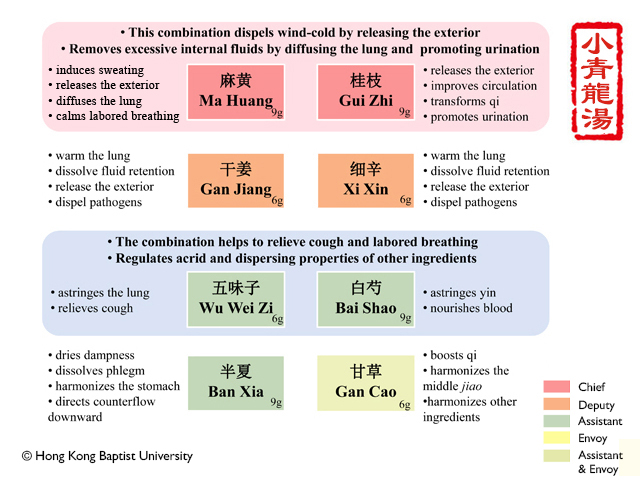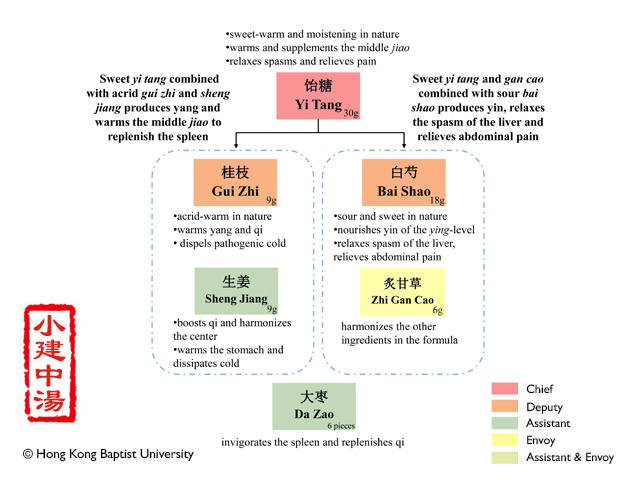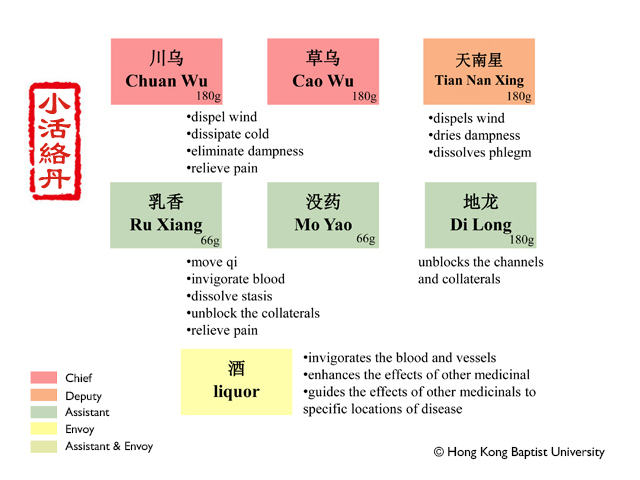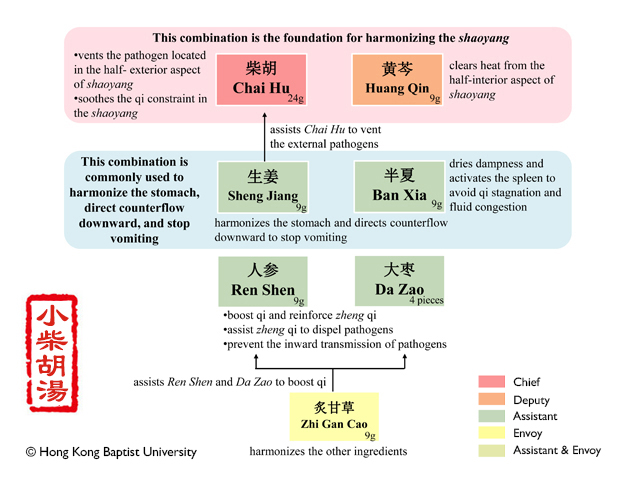| Numbering |
|
Name |
|
Combination |
|
Action |
|
Indication |
|
Thumbnail |
|
21
|
|
Minor Green Dragon Decoction
|
|
Ephedrae Herba; Paeoniae Radix Alba; Asari Radix et Rhizoma; Zingiberis Rhizoma; Glycyrrhizae Radix et Rhizoma; Cinnamomi Ramulus; Pinelliae Rhizoma; Schisandrae Chinensis Fructus
|
|
Releases the exterior, dissipates cold, warms the lung and dissolves rheum (fluid retention).
|
|
This formula is indicated for the pattern of exterior cold with interior fluid retention. The symptoms are aversion to cold, fever, absence of sweating, labored breathing, cough, copious clear and thin phlegm, stuffiness in chest, dry retching, difficulty in lying back in the supine position, general body aches, edema of the face and extremities. The tongue coating is white and glossy, and the pulse is superficial.
|
|

|
|
22
|
|
Minor Center-Fortifying Decoction
|
|
Cinnamomi Ramulus; Glycyrrhizae Radix et Rhizoma; Jujubae Fructus; Paeoniae Radix Alba; Zingiberis Rhizoma Recens; Saccharum Granorum
|
|
Warms the center, supplements deficiency, harmonizes the interior, and relaxes spasms.
|
|
Deficiency-cold of the middle jiao, disharmony of the liver and spleen, characterized by abdominal spasms and pain which can be lessened by warmth and pressure, fatigue and lack of strength, shortness of breath, palpitations, dysphoria, pale complexion, or sore limbs, vexing heat in the palms, dry throat, a pale tongue with white coating, and a thready, wiry pulse.
|
|

|
|
23
|
|
Minor Channel-Activating Elixir
|
|
Aconiti Radix Cocta; Aconiti Kusnezoffii Radix Cocta; Pheretima; Arisaematis Rhizoma Preparatum; Olibanum; Myrrha
|
|
Dispels wind and eliminates dampness, dissolves phlegm to unblock the collaterals, and invigorates blood to relieve pain.
|
|
1. Bi syndrome due to wind, cold, and dampness characterized by pain, numbness, and spasms of the limbs, body and sinews, dysfunction with bending and stretching the joints, wandering pain, a pale purple tongue body with a white tongue coating, and a deep, wiry or choppy pulse.
2. Wind-strike due to dampness, phlegm, and blood stasis obstructing the collaterals characterized by persistent numbness and weakness of the limbs, heavy sensation in the waist and legs, or pains in the legs and arms, etc.
|
|

|
|
24
|
|
Minor Bupleurum Decoction
|
|
Bupleuri Radix; Scutellariae Radix; Ginseng Radix et Rhizoma; Glycyrrhizae Radix et Rhizoma; Pinelliae Rhizoma; Zingiberis Rhizoma Recens; Jujubae Fructus
|
|
|
|
1. Cold damage entering the shaoyang. The symptoms are alternating chills and fever, fullness and discomfort in the chest and rib-side, no desire to eat or drink, vexation and frequent vomiting, bitter taste in the mouth, dry throat, dizzy vision, a thin white tongue coating, and a wiry pulse.
2. Heat entering the blood chamber (uterus). The symptoms are feminine wind-invasion syndrome, inhibited menstrual flow, periodic alternating chills and fever, malaria, and jaundice when the patient shows signs of a shaoyang pattern.
|
|

|

